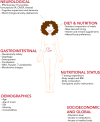To restrict or not to restrict? Practical considerations for optimizing dietary protein interactions on levodopa absorption in Parkinson's disease
- PMID: 37355689
- PMCID: PMC10290638
- DOI: 10.1038/s41531-023-00541-w
To restrict or not to restrict? Practical considerations for optimizing dietary protein interactions on levodopa absorption in Parkinson's disease
Abstract
Administration of levodopa for Parkinson's disease (PD) has remained the most effective therapy for symptom management despite being in use for over 50 years. Advancing disease and age, changing tolerability and gastrointestinal (GI) dysfunction may result in change in dietary habits and body weight, as well as unpredictable motor fluctuations and dyskinesias. Dietary proteins which convert into amino acids after digestion are implicated as major factors that inhibit levodopa absorption. For people living with PD (PwP) who experience motor fluctuations, low protein diets (LPD) and protein redistribution diets (PRD) may be effective and are often recommended as a non-pharmacologic approach for improving levodopa bioavailability. However, there is a lack of consensus on a standard definition of these diets and appropriate treatment algorithms for usage. This may be due to the paucity of high-level evidence of LPD and PRD in PwP and whether all or specific subgroups of patients would benefit from these strategies. Managing diet and protein intake with proper education and monitoring may reduce complications associated with these diets such as dyskinesias and unintentional weight loss. Additionally, alterations to medications and GI function may alter levodopa pharmacokinetics. In this narrative review we focus on 1) mechanisms of dietary protein and levodopa absorption in the intestine and blood brain barrier, 2) dietetic approaches to manage protein and levodopa interactions and 3) practical issues for treating PwP as well as future directions to be considered.
© 2023. The Author(s).
Conflict of interest statement
C.R. is now an employee of Abbott Nutrition, Columbus, OH, USA; however, this work was completed while C.R. was affiliated with the University of Florida. R.F., H.S., and I.S. declare no competing interests.
Figures


Similar articles
-
Protein-Restricted Diets for Ameliorating Motor Fluctuations in Parkinson's Disease.Front Aging Neurosci. 2017 Jun 28;9:206. doi: 10.3389/fnagi.2017.00206. eCollection 2017. Front Aging Neurosci. 2017. PMID: 28701947 Free PMC article. Review.
-
Motor fluctuations due to interaction between dietary protein and levodopa in Parkinson's disease.J Clin Mov Disord. 2016 May 26;3:8. doi: 10.1186/s40734-016-0036-9. eCollection 2016. J Clin Mov Disord. 2016. PMID: 27231577 Free PMC article.
-
Gastrointestinal barriers to levodopa transport and absorption in Parkinson's disease.Eur J Neurol. 2023 May;30(5):1465-1480. doi: 10.1111/ene.15734. Epub 2023 Mar 7. Eur J Neurol. 2023. PMID: 36757008 Review.
-
Model-based dietary optimization for late-stage, levodopa-treated, Parkinson's disease patients.NPJ Syst Biol Appl. 2016 Jun 16;2:16013. doi: 10.1038/npjsba.2016.13. eCollection 2016. NPJ Syst Biol Appl. 2016. PMID: 28725472 Free PMC article.
-
Dietary habits and neurological features of Parkinson's disease patients: Implications for practice.Clin Nutr. 2017 Aug;36(4):1054-1061. doi: 10.1016/j.clnu.2016.06.020. Epub 2016 Jul 5. Clin Nutr. 2017. PMID: 27406858
Cited by
-
The Role of Diet in Parkinson's Disease.J Parkinsons Dis. 2024;14(s1):S21-S34. doi: 10.3233/JPD-230264. J Parkinsons Dis. 2024. PMID: 38251061 Free PMC article. Review.
-
Refining the clinical diagnosis of Parkinson's disease.Parkinsonism Relat Disord. 2024 May;122:106041. doi: 10.1016/j.parkreldis.2024.106041. Epub 2024 Feb 10. Parkinsonism Relat Disord. 2024. PMID: 38360507 Free PMC article. Review.
-
Microbiota-gut-brain axis and its therapeutic applications in neurodegenerative diseases.Signal Transduct Target Ther. 2024 Feb 16;9(1):37. doi: 10.1038/s41392-024-01743-1. Signal Transduct Target Ther. 2024. PMID: 38360862 Free PMC article. Review.
-
Outcomes of dietary interventions in the prevention and progression of Parkinson's disease: A literature review.AIMS Neurosci. 2024 Dec 30;11(4):520-532. doi: 10.3934/Neuroscience.2024032. eCollection 2024. AIMS Neurosci. 2024. PMID: 39801794 Free PMC article. Review.
-
Management of Osteoporosis in Parkinson's Disease: A Systematic Review of Clinical Practice Guidelines.Mov Disord Clin Pract. 2025 Mar;12(3):285-295. doi: 10.1002/mdc3.14311. Epub 2024 Dec 20. Mov Disord Clin Pract. 2025. PMID: 39704021 Free PMC article.
References
-
- Siegfried J, et al. Treatment of Parkinsonism with L-Dopa in association with a decarboxylase inhibitor. Pharmacologia Clin. 1969;2:23–26. doi: 10.1007/BF00404181. - DOI
Publication types
LinkOut - more resources
Full Text Sources
Miscellaneous

